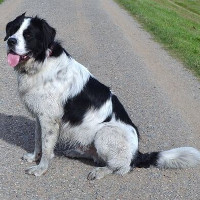Appearance of the Labernard
|
| Labernards are large to giant dogs whose parent breeds are Labrador Retrievers and St. Bernards. They have thick double coats that are short and dense, and common colors are yellow, brown, beige, black and red with white markings. They are powerfully built, muscular dogs with large heads and often have wrinkles on their foreheads. They have a friendly, intelligent expression. They have dark brown eyes and the ears are set fairly high on the head but hang over the face. They are likely to have a long, thick and perhaps bushy tail and a black nose. |
Temperament of the Labernard
|
| The Labernard is a gentle, friendly, family-loving dog that is very tolerant and patient with children. Because of their size, young children need to be supervised around them to avoid accidental injury. They are good with strangers because of their gentle personalities, but bark to alert the family of intruders. These dogs don't do well left to their own devices and will thrive with large, active families where there's someone at home most of the time. Labernards will need a firm, confident hand in training, as they have a mind of their own. But being intelligent, they will respond to positive reinforcement and once trained, are obedient dogs eager to please. The Labernard will always be up for an outing, whether it's a long walk or a hike in the mountains. But with their thick coats, they're not good at hot weather and can suffer from heat exhaustion. Try to exercise them in cooler weather, and make sure they have plenty of water. |
Needs and activities of the Labernard
|
| A Labernard is an energetic, active dog that will need daily exercise. This will depend on which parent breed your dog follows the most, as Labrador Retrievers need much more intensive exercise compared to a St. Bernard, which does well with walks but not with high-impact sports like running. St. Bernards don't do well in the heat, so be careful in summer when exercising your pet. A Labernard will do better in a house with a fenced-in yard than in an apartment. Ball games will keep him happy and mentally stimulated, and prevent any bad behavior from developing. Your puppy will love playing outdoors, but he's not an outdoor dog and will need to live indoors with the family. |
Maintenance of the Labernard
|
| Your Labernard will need regular brushing with a pin brush to get rid of any loose hair and to avoid tangles. Grooming requirements are not excessive, but brushing every other day will keep your pet in good health. If the hair is a little longer, daily brushing is a good idea. These dogs are not hypoallergenic and drool a little, which is something for owners to bear in mind. A shedding blade can be used during periods of heavy shedding. Fortunately, these big dogs don't need to be bathed very often, and only if they get very dirty. Because they are prone to ear infections, ears should be checked frequently for any signs of irritation. Nails should also be checked to see if they need trimming. Teeth should be brushed to prevent tartar build-up and help keep bad breath at bay. |









 English (United Kingdom)
English (United Kingdom)